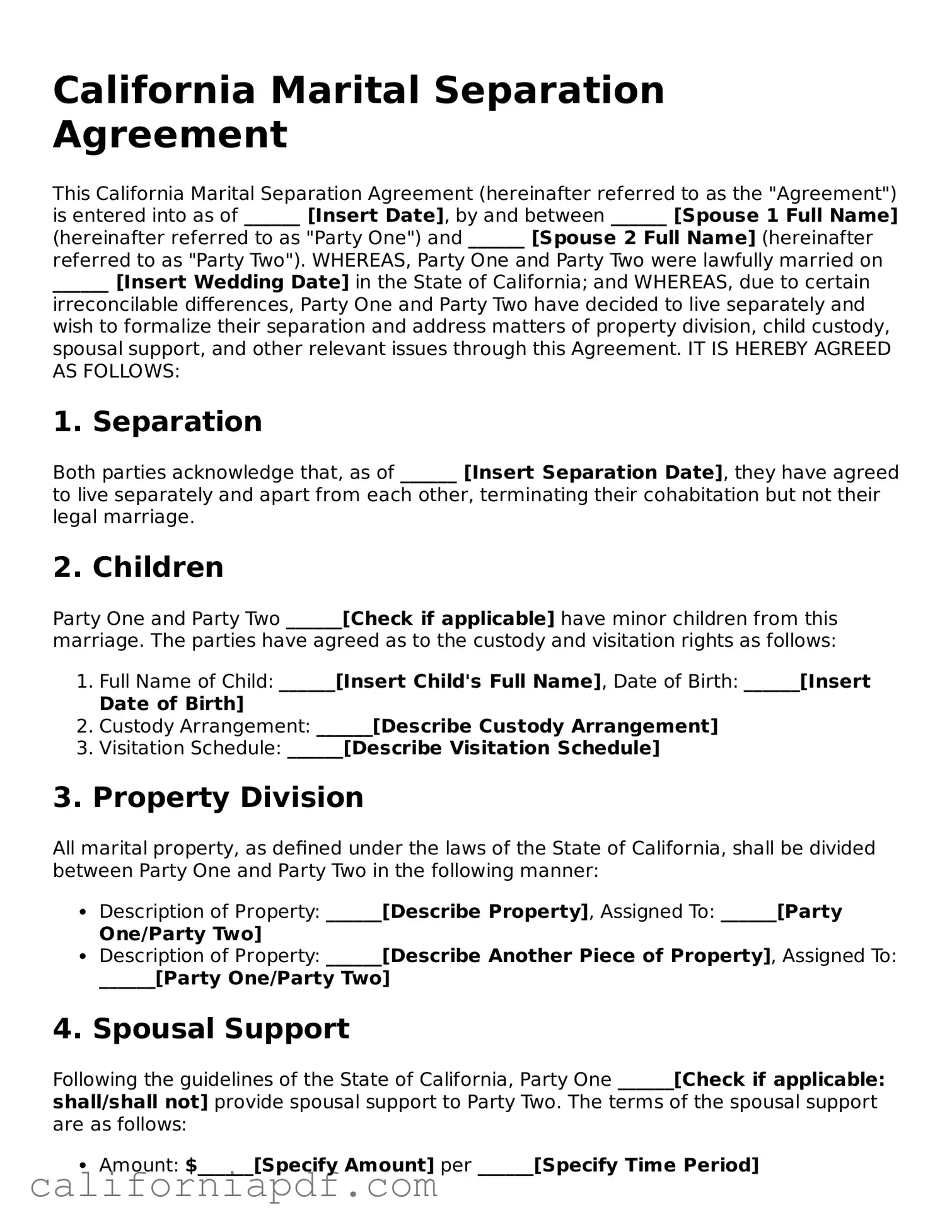California Marital Separation Agreement
This California Marital Separation Agreement (hereinafter referred to as the "Agreement") is entered into as of ______ [Insert Date], by and between ______ [Spouse 1 Full Name] (hereinafter referred to as "Party One") and ______ [Spouse 2 Full Name] (hereinafter referred to as "Party Two"). WHEREAS, Party One and Party Two were lawfully married on ______ [Insert Wedding Date] in the State of California; and WHEREAS, due to certain irreconcilable differences, Party One and Party Two have decided to live separately and wish to formalize their separation and address matters of property division, child custody, spousal support, and other relevant issues through this Agreement. IT IS HEREBY AGREED AS FOLLOWS:
1. Separation
Both parties acknowledge that, as of ______ [Insert Separation Date], they have agreed to live separately and apart from each other, terminating their cohabitation but not their legal marriage.
2. Children
Party One and Party Two ______[Check if applicable] have minor children from this marriage. The parties have agreed as to the custody and visitation rights as follows:
- Full Name of Child: ______[Insert Child's Full Name], Date of Birth: ______[Insert Date of Birth]
- Custody Arrangement: ______[Describe Custody Arrangement]
- Visitation Schedule: ______[Describe Visitation Schedule]
3. Property Division
All marital property, as defined under the laws of the State of California, shall be divided between Party One and Party Two in the following manner:
- Description of Property: ______[Describe Property], Assigned To: ______[Party One/Party Two]
- Description of Property: ______[Describe Another Piece of Property], Assigned To: ______[Party One/Party Two]
4. Spousal Support
Following the guidelines of the State of California, Party One ______[Check if applicable: shall/shall not] provide spousal support to Party Two. The terms of the spousal support are as follows:
- Amount: $______[Specify Amount] per ______[Specify Time Period]
- Duration: ______[Specify Duration]
- Other terms: ______[Describe any additional terms]
5. Child Support
In accordance with California child support guidelines, Party One ______[Check if applicable: shall/shall not] provide child support to Party Two. The details are outlined as follows:
- Amount: $______[Specify Amount] per ______[Specify Time Period]
- Duration: ______[Specify Duration]
- Other terms: ______[Describe any additional terms]
6. Debts and Liabilities
Both parties are responsible for the debts and liabilities incurred during their marriage in the following manner:
- Description of Debt/Liability: ______[Describe Debt], Assigned To: ______[Party One/Party Two]
- Description of Debt/Liability: ______[Describe Another Debt], Assigned To: ______[Party One/Party Two]
7. General Provisions
This Agreement represents the entire understanding between Party One and Party Two regarding their separation and supersedes all prior negotiations, understandings, and agreements. Any amendments to this Agreement must be made in writing and signed by both parties.
IN WITNESS WHEREOF, the Parties have executed this Agreement as of the date first above written.
Signature of Party One: _____________________ Date: ______
Signature of Party Two: _____________________ Date: ______
